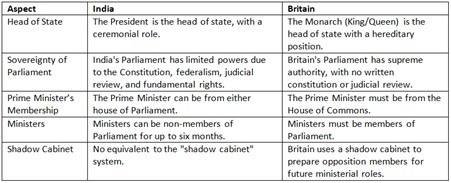Parliamentary System
The Constitution of India establishes a parliamentary form of government at both the national and state levels. Articles 74 and 75 pertain to the parliamentary system at the Centre, while Articles 163 and 164 address the system in the states.
Modern democratic governments are typically categorized into parliamentary and presidential systems, based on the nature of the relationship between the executive and legislative branches. In a parliamentary system, the executive is accountable to the legislature for its policies and actions. Conversely, a presidential system is characterized by an executive that operates independently of the legislature and is not held responsible for its policies and actions, meaning it has a constitutionally fixed term of office.
The parliamentary government is also referred to as a cabinet government or responsible government, often associated with the Westminster model, which is prevalent in countries like Britain, Japan, Canada, and India. In contrast, the presidential system is sometimes called a non-responsible, non-parliamentary, or fixed executive system, commonly found in nations such as the USA, Brazil, Russia, and Sri Lanka.
Ivor Jennings referred to the parliamentary system as the ‘cabinet system,’ emphasizing that the cabinet serves as the core of power within this framework. It is also termed ‘responsible government’ because the cabinet—the actual executive body—accounts to Parliament and continues in office as long as it maintains the confidence of the legislative body. This model is often called the ‘Westminster model of government’ after the British Parliament’s location, where the system originated.
Historically, British constitutional and political experts referred to the Prime Minister as ‘primus inter pares’ (first among equals) in relation to the cabinet. However, in recent times, the Prime Minister’s power, influence, and position have significantly increased in relation to the cabinet. Consequently, later political analysts, including Crossman, Mackintosh, and others, have described the British system as ‘prime ministerial government.’ This characterization is equally applicable to the Indian political context.
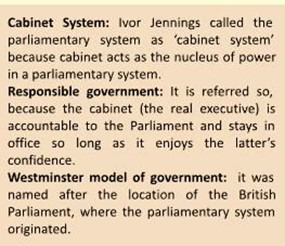
Features of Parliamentary Government
The parliamentary government in India exhibits several distinctive features or principles:
1. Nominal and Real Executives
- The President serves as the nominal executive (de jure executive or titular executive), while the Prime Minister functions as the real executive (de facto executive). Thus, the President is the head of the State, whereas the Prime Minister is the head of the government. Article 74 provides for a council of ministers, headed by the Prime Minister, to aid and advise the President in executing his functions. The advice offered by this council is binding on the President.
2. Majority Party Rule
- The political party that secures the majority of seats in the Lok Sabha forms the government. The leader of this party is appointed as the Prime Minister by the President, and other ministers are appointed on the Prime Minister’s advice. In instances where no single party achieves a majority, the President may invite a coalition of parties to form the government.
3. Collective Responsibility
- This principle is foundational to parliamentary governance. The ministers are collectively responsible to the Parliament in general and specifically to the Lok Sabha (Article 75). They operate as a team, sharing the consequences of their decisions. The principle of collective responsibility implies that the Lok Sabha can remove the entire ministry (the council of ministers headed by the Prime Minister) from office through a vote of no confidence.
4. Political Homogeneity
- Members of the council of ministers typically belong to the same political party, reflecting a shared political ideology. In a coalition government, consensus among parties is essential for effective governance.
5. Double Membership
- Ministers are members of both the legislature and the executive branches. A person cannot serve as a minister without being a member of Parliament. The Constitution stipulates that if a minister is not a member of Parliament for six consecutive months, they cease to hold office.
6. Leadership of the Prime Minister
- The Prime Minister assumes a leadership role in this system of government. As the leader of the council of ministers, the Parliament, and the ruling party, the Prime Minister plays a significant and crucial role in the government’s functioning.
7. Dissolution of the Lower House
- The Lok Sabha, the lower house of Parliament, can be dissolved by the President upon the recommendation of the Prime Minister. This means that the Prime Minister can advise the President to dissolve the Lok Sabha before the end of its term and call for fresh elections, thereby granting the executive the power to dissolve the legislature.
8. Secrecy
- Ministers operate under the principle of secrecy regarding their procedures and cannot disclose information concerning their proceedings, policies, or decisions. They take an oath of secrecy before assuming office, which is administered by the President.
These features collectively ensure the efficient functioning and accountability of the parliamentary government in India.
Features of Presidential Government
Unlike the parliamentary system outlined in the Indian Constitution, the American Constitution establishes a presidential form of government. The features of the American presidential system include the following:
1. Dual Role of the President
- The American President serves as both the head of State and the head of government. In the capacity of head of State, the President holds a primarily ceremonial position, whereas, as head of government, the President leads the executive branch of government.
2. Election and Tenure
- The President is elected by an electoral college for a fixed term of four years. The President can only be removed from office through impeachment by Congress in the case of serious unconstitutional conduct.
3. Cabinet Structure
- The President works with a cabinet or a smaller group known as the ‘Kitchen Cabinet.’ This advisory body consists of non-elected departmental secretaries who are appointed by the President, report directly to him, and can be dismissed at any time.
4. Independence from Congress
- The President and his secretaries are not accountable to Congress for their actions. They do not hold membership in Congress and do not participate in its sessions.
5. No Power to Dissolve Congress
- The President does not have the authority to dissolve the House of Representatives, which is the lower house of Congress.
6. Separation of Powers
- The doctrine of separation of powers underpins the American presidential system. In this framework, the legislative, executive, and judicial powers of government are distinct and allocated to separate branches, ensuring a system of checks and balances.
These features collectively define the structure and operation of the American presidential government, distinguishing it from parliamentary systems like that of India.
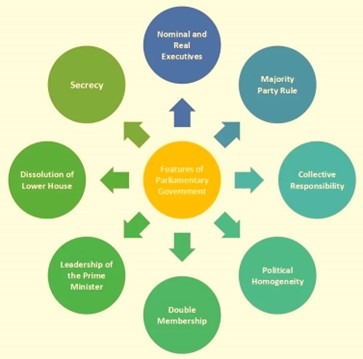
Merits of the Parliamentary System
The parliamentary system of government offers several advantages:
1. Harmony Between Legislature and Executive
- One of the key advantages of the parliamentary system is the promotion of a harmonious relationship and cooperation between the legislative and executive branches of government. Since the executive is part of the legislature, both branches are interdependent, leading to fewer disputes and conflicts.
2. Responsible Government
- The parliamentary system inherently establishes a responsible government. Ministers are accountable to Parliament for their actions, both in terms of what they do and fail to do. Parliament exercises control over the ministers through various mechanisms, such as question hours, discussions, adjournment motions, and no-confidence motions.
3. Prevention of Despotism
- In this system, executive authority is distributed among a group (the council of ministers) rather than concentrated in a single individual. This dispersal of power helps curb dictatorial tendencies within the executive. Additionally, the council of ministers is accountable to Parliament and can be removed through a no-confidence motion.
4. Ready Alternative Government
- If the ruling party loses its majority, the Head of State can invite the opposition party to form the government. This allows for the establishment of an alternative government without the need for new elections. Dr. Jennings famously stated that ‘the leader of the opposition is the alternative prime minister.’
5. Wide Representation
- In a parliamentary system, the executive is composed of a group of individuals (ministers), who are typically representatives of the people. Thus, it is possible to ensure representation for various sections and regions within the government. The Prime Minister can consider this factor when selecting ministers, fostering inclusivity.
These merits contribute to the effectiveness and adaptability of the parliamentary system, allowing for responsive governance and representation of diverse interests within society.
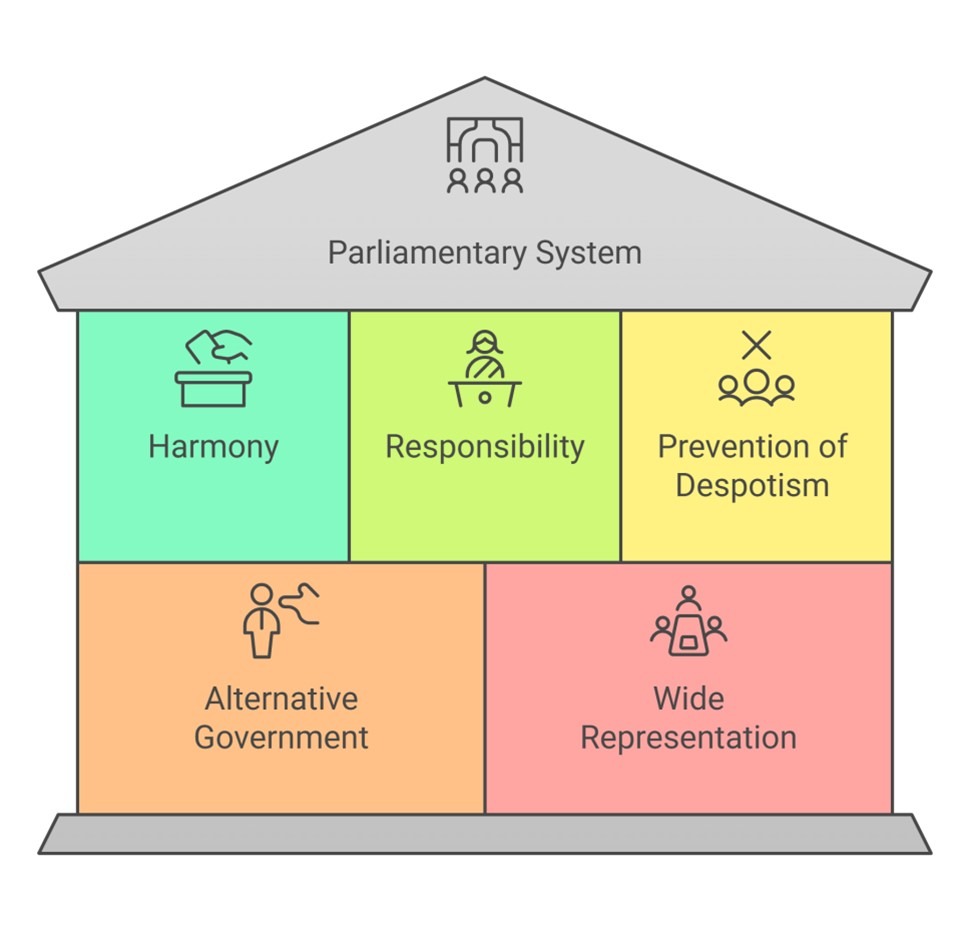
Demerits of the Parliamentary System
Despite its advantages, the parliamentary system has several notable drawbacks:
1. Unstable Government
- One of the primary issues of the parliamentary system is its tendency to produce unstable governments. There is no guarantee that a government will complete its full term, as ministers rely on support from the majority within the legislature. Factors such as no-confidence motions, political defections, or the complexities of multiparty coalitions can lead to governmental instability. Historical examples include the governments led by Morarji Desai, Charan Singh, V.P. Singh, Chandra Sekhar, Deva Gowda, and I.K. Gujral.
2. Inconsistency in Policies
- The parliamentary framework poses challenges for the establishment and execution of long-term policies due to the inherent uncertainty of government tenure. When a ruling party changes, it often triggers significant shifts in policy direction. For instance, the Janata Government under Morarji Desai in 1977 reversed many policies introduced by the previous Congress Government, a pattern that continued when Congress returned to power in 1980.
3. Cabinet Autocracy
- When the ruling party has a clear majority in Parliament, the cabinet may become authoritarian, wielding almost unchecked power. H.J. Laski pointed out that the parliamentary system can facilitate tyranny within the executive. Ramsay Muir, a former British Prime Minister, also expressed concerns about the “dictatorship of the cabinet.” This issue was particularly evident during the terms of Indira Gandhi and Rajiv Gandhi.
4. Contradiction to Separation of Powers
- In the parliamentary system, the legislative and executive branches are intertwined, making them inseparable. The cabinet serves as the leader of both branches. Bagehot described this relationship by stating that “the cabinet is a hyphen that joins the buckle that binds the executive and legislative departments together.” As a result, this arrangement undermines the principle of separation of powers, resulting in a fusion of powers.
5. Amateur Governance
- The parliamentary system may hinder administrative efficiency, as ministers often lack expertise in their respective fields. The Prime Minister’s selection of ministers is confined to members of Parliament, limiting the inclusion of outside talent and expertise. Additionally, ministers typically invest significant time in parliamentary responsibilities, cabinet meetings, and party engagements, detracting from their ability to govern effectively.
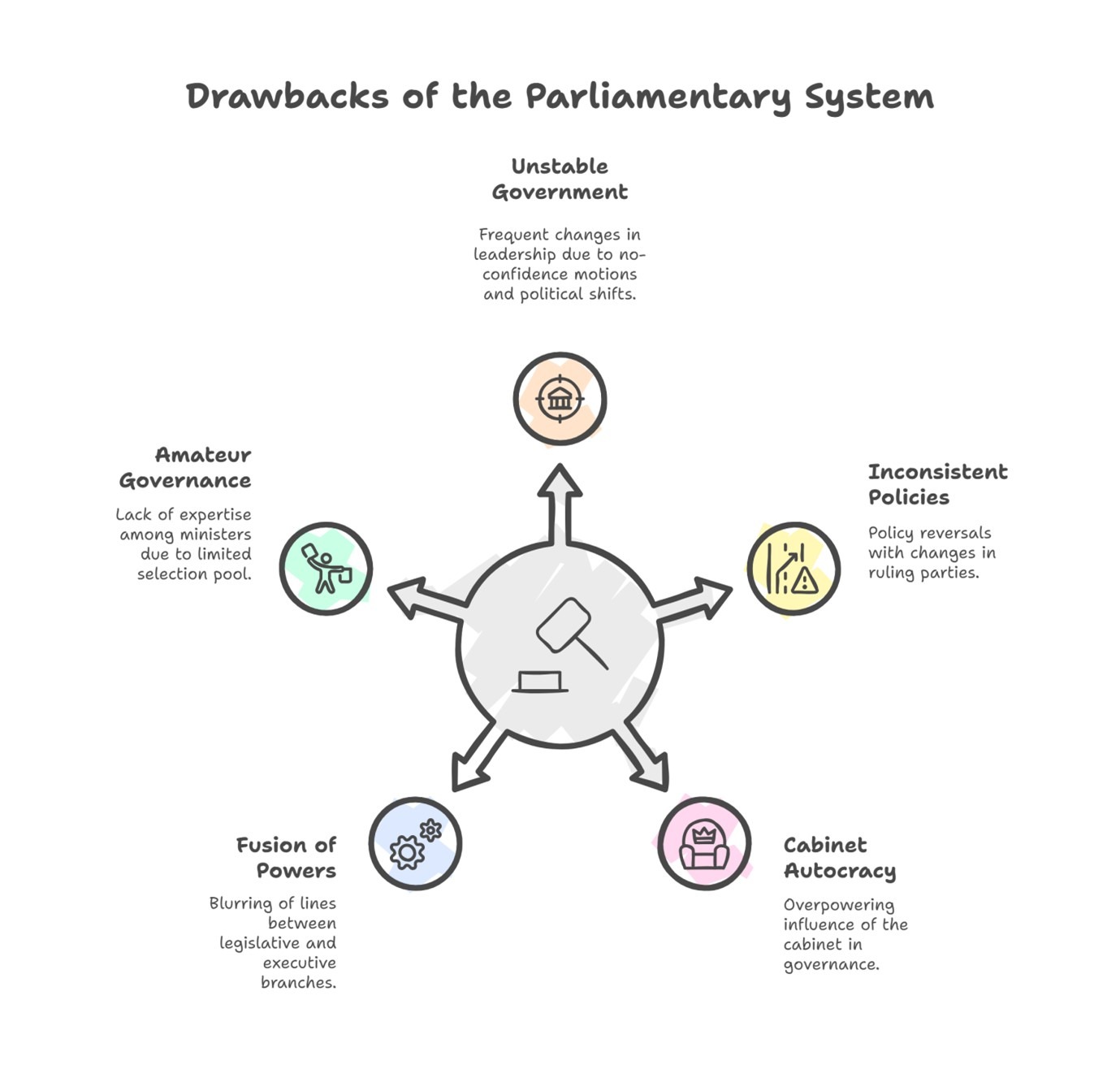
Comparison of Parliamentary and Presidential Systems
In comparing the parliamentary and presidential systems, several key distinctions emerge regarding their features, benefits, and shortcomings:
- Stability: The presidential system generally offers more stable governance due to fixed terms, while the parliamentary system is often vulnerable to instability stemming from shifting political alliances and confidence votes.
- Policy Continuity: The presidential system tends to maintain greater consistency in government policies, while changes in leadership in parliamentary systems often result in policy reversals.
- Separation of Powers: The presidential system adheres more strictly to the doctrine of separation of powers, whereas the parliamentary system experiences a blending of legislative and executive functions.
- Accountability: In parliamentary systems, ministers are directly accountable to the legislature, which encourages greater oversight, while the presidential system grants executives a certain degree of independence from legislative control.
- Expertise in Administration: The presidential system has more flexibility to recruit experienced individuals for executive positions, whereas the parliamentary system often restricts ministerial appointments to elected officials who may lack specialized knowledge in key areas.
This analysis highlights the respective strengths and weaknesses of both systems, illustrating how each may offer unique governance advantages depending on the specific political context.
Comparison of Parliamentary and Presidential Systems
Category | Parliamentary System | Presidential System |
Features: | 1. Dual executive (Head of State and Head of Government) | 1. Single executive (President) |
Merits: | 1. Promotes harmony between the legislature and executive | 1. Ensures a stable government |
Demerits: | 1. Potential for conflict between the legislature and executive | 1. Unstable government prone to changes |
The preference for the parliamentary model was based on its strengths, such as its ability to maintain government stability and accountability, facilitate cooperation among branches of government, and ensure representation for diverse groups in society. These factors were decisive in the choice to adopt a parliamentary system tailored to the Indian political context.
Reasons for Adopting the Parliamentary System
While there were arguments in favour of adopting the U.S. presidential system of government during the discussions in the Constituent Assembly, the founding fathers ultimately preferred the British parliamentary system for several compelling reasons.
1. Familiarity with the System
- The Constitution-makers had a degree of familiarity with the parliamentary system, as it had been in practice in India during British rule. K.M. Munshi argued that over the last thirty to forty years, some form of responsibility had been introduced into governance in India. He emphasized that the constitutional traditions had evolved to be parliamentary in nature, stating, “After this experience, why should we revert to an entirely new system?”
2. Preference for Greater Responsibility
- Dr. B.R. Ambedkar highlighted during the Constituent Assembly discussions that a democratic executive must fulfill two essential criteria: stability and responsibility. However, he noted the difficulty in crafting a system that could achieve both to an equal extent. The American system provides greater stability but less accountability, while the British system offers increased responsibility at the expense of stability. The Draft Constitution ultimately favored the parliamentary system for its emphasis on responsibility over stability.
3. Avoidance of Legislative–Executive Conflicts
- The framers of the Constitution sought to prevent conflicts between the legislature and the executive, which they believed are likely to arise in the presidential system, as seen in the United States. They reasoned that a nascent democracy could not afford the risks associated with ongoing conflicts or tensions between these two branches of government. Their goal was to establish a governance model that would support the diverse development needs of the country.
4. Nature of Indian Society
- India is recognized as one of the most heterogeneous and complex plural societies globally. The Constitution-makers adopted the parliamentary system because it allows for greater representation of various groups, interests, and regions within the government. This representation fosters a sense of national unity and helps build a cohesive India.

The ongoing debate regarding whether to retain the parliamentary system or shift to a presidential system has been a recurring theme in India since the 1970s. The Swaran Singh Committee, established by the Congress government in 1975, thoroughly examined this issue and concluded that the parliamentary system has been functioning well; therefore, there is no need to transition to a presidential system.
Distinctions between the Indian and British Models
While the parliamentary system of government in India draws heavily from the British parliamentary system, it is not a mere replica and exhibits several key differences:
1. Type of Head of State
- India operates under a republican system, whereas Britain has a monarchical system. The Head of State in India, the President, is elected, whereas the Head of State in Britain, the King or Queen, holds a hereditary position.
2. Sovereignty of Parliament
- The British parliamentary system is founded on the doctrine of parliamentary sovereignty, which means Parliament holds supreme power. In contrast, Indian Parliament does not enjoy absolute sovereignty; its powers are limited and defined by a written Constitution, a federal structure, judicial review, and the protection of fundamental rights.
3. Membership Requirements for Prime Minister
- In Britain, the Prime Minister must be a member of the Lower House, known as the House of Commons. In India, the Prime Minister may be a member of either House of Parliament, allowing for greater flexibility.
4. Appointment of Ministers
- Typically, ministers in Britain are drawn exclusively from Parliament. In India, it is possible for individuals who are not members of Parliament to be appointed as ministers, although such appointments are temporary and must be regularized within six months.
5. Legal Responsibility of Ministers
- The British system entails a legal responsibility for ministers, requiring them to countersign the official acts of the Head of State. In contrast, Indian ministers do not have such a legal obligation to countersign the actions taken by the President.
6. Presence of a Shadow Cabinet
- The British system features a “shadow cabinet,” formed by the opposition party to scrutinize the actions of the ruling cabinet and prepare its members for potential future ministerial roles. India does not have an equivalent institution to serve this purpose.
These distinctions highlight the unique characteristics of the Indian parliamentary system while demonstrating how it has been adapted from its British counterpart to better suit the Indian political context.
